[Comparison table] Best aquarium heaters (titanium & glass) with size guide
Aquarium heaters are used to ensure the temperature is maintained at a steady and proper level for tropical fish. This equipment is extremely important for the fish since they are coldblooded and maintain their body temperature based on surrounding conditions. Wrong temperatures can stress the fish that leads to a significant decrease in their disease-resistant ability. In this article, you will learn what to look for when buying a new heater for your fish.
- [Comparison] Best glass & titanium aquarium heaters
- 5 Types of aquarium heaters
- What size heater (watt) for aquarium?
- Fish tank heater reviews (sorted from small to large)
- Aqueon Aquatic flat heater 7.5-watt
- FREESEA glass aquarium heater
- HiTauing Aquarium Heater with External Controller
- Hygger Titanium Tube Heater with separate thermometer probe
- Hygger Titanium Aquarium Heater with controller
- AquaTop Titanium Aquarium Heater with Controller
- Fluval M Submersible Glass Aquarium Heater
- Orlushy submersible aquarium heater, budget option
- Aqueon Pro Submersible Aquarium Heater
- Eheim Jager TruTemp Submersible Heater
- Vivosun 300W Titanium Heater with Controller
- HITOP Digital Titanium Heater with External Controller
- Finnex Deluxe Titanium Tube Heater 800-watt
- How to install an aquarium heater?
- Accessories and replacement components
- Frequently asked questions and common problems
[Comparison] Best glass & titanium aquarium heaters
| Model | Our rating | Type | Wattage | For tanks | Temperature range | Features |
|---|---|---|---|---|---|---|
 |
 Aqueon Aquatic Flat Heater #ad Aqueon Aquatic Flat Heater #ad |
plastic pad | 7.5 watts (15W available) | 1-3 gallons | preset for tropical fish, can’t set | – |
 |
 FREESEA Aquarium Heater #ad FREESEA Aquarium Heater #ad |
glass tube | 25 watts (25-100W available) | 1 – 5 gallons, Betta, tropical fish | 63-95°F, adjustable | light indicator, digital thermometer |
 |
 HiTauing Aquarium Heater with External Controller #ad HiTauing Aquarium Heater with External Controller #ad |
glass tube with guard and digital controller | 50 watts (50-500W available) | 5-10 gallons | 63-94°F (17-34°C), ±1°F | dual-temp display, °F & °C switch, out of water protection |
 |
 Hygger Titanium Tube Heater with Controller #ad Hygger Titanium Tube Heater with Controller #ad |
titanium tube with external controller | 200W (50-500W available) | 20 – 45 gallons, freshwater or saltwater | 32-104°F, ±1°F error, adjustable | dual-temp display, separate thermometer probe, °F or °C reading |
 |
 Hygger Titanium Aquarium Heater with controller #ad Hygger Titanium Aquarium Heater with controller #ad |
titanium tube with guard and digital controller | 500W (800W available) | 60-120 gallons | 70-94°F, ±1°F error, adjustable | real-time water temperature, anti-dry protection |
 |
 AquaTop Titanium Heater w/Controller #ad AquaTop Titanium Heater w/Controller #ad |
titanium tube with external controller | 100 Watt (100-500W available) | up to 35 gallons | 68-92°F (±1°F), adjustable | water temperature reading, separated thermometer probe |
 |
 Fluval M Submersible Heater #ad Fluval M Submersible Heater #ad |
glass tube | 100 watt (50-200W available) | up to 30 Gal | 66-86°F | light indicator, blends into the aquarium environment |
 |
 Orlushy Submersible Aquarium Heater #ad Orlushy Submersible Aquarium Heater #ad |
glass tube | 150W (100-500W available) | 30 – 50 Gal | 68-89°F, ±1°F, adjustable | LED light indicator, include a digital thermometer |
 |
 Aqueon Pro Submersible Heater #ad Aqueon Pro Submersible Heater #ad |
plastic tube | 100 Watt (50-150W available) | 20-30 Gal | 68-88°F, ±1°F | LED light indicator |
 |
 Eheim Jager Aquarium Thermostat Heater #ad Eheim Jager Aquarium Thermostat Heater #ad |
glass tube | 250 watts (75-300W available) | 55-60 gallons | 64.4-93.2°F (18-34°C) | operation light, running-fry prevention |
 |
 Vivosun 300W Titanium Heater with Controller #ad Vivosun 300W Titanium Heater with Controller #ad |
titanium tube with external controller | 300W (50-400W available) | 50 – 60 Gal | 68-94°F (20-34°C), ±2°F/1°C | water temp reading, separate digital thermometer, running dry protection |
 |
 HITOP 600W Digital Titanium Heater with External Controller #ad HITOP 600W Digital Titanium Heater with External Controller #ad |
titanium tube with controller | 600 watts | 75-180 Gal | 64-93°F (18-34°C), ±1°F | dual-temp display, °F & °C switch, out of water protection |
 |
 Finnex Deluxe Titanium Tube Heater #ad Finnex Deluxe Titanium Tube Heater #ad |
titanium tube with external controller | 800 watts (300/500/800W available) | 140 – 265 gallons | 0-99°F, ±2°F, adjustable | water temperature reading |
5 Types of aquarium heaters
1. Glass heater
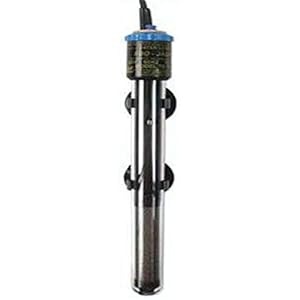 Eheim Jager Aquarium Thermostat Heater #ad
Eheim Jager Aquarium Thermostat Heater #ad
Glass heaters are the most common and budget-friendly option in the market. They come in different lengths and wattages to suit different tank sizes. This type of heater is best known for how easy it is to set up and operate.
Ensure you choose a high-quality glass heater because it is very risky to use when the glass is made from poor-quality glass. You should ensure the heater is fully submerged in the water while operating or the glass will be broken after a short service time. Choosing a glass heater with a running-dry protection feature is strongly recommended.
2. Titanium heater
 Hygger Titanium Tube Heater with Controller #ad
Hygger Titanium Tube Heater with Controller #ad
These are newer, higher quality additions to the market. You might have to dig deeper into your pockets for this type of heaters, but it’s worth it, considering you don’t have to worry about any breakage, shattering, and exploding.
Most titanium heaters come with a separate controller placed outside the aquarium. The controller saves you from wetting your hands every time you want to adjust the temperature.
3. Inline heater
 Datoo In-Line External Heater #ad
Datoo In-Line External Heater #ad
For aquarists concerned about appearance and the unobstructed view of their aquarium, inline heaters are the best option. The most basic type features a pipe with a heating element that heats the water as it flows through. This heater is usually attached to the intake or output hose of a canister filter.
Besides staying clear from view, inline heaters are incredibly safe for you and your fish and provide even heating because the water passing through the heater circulates inside the tank and distributes the heat.
On the downside, inline heaters are more expensive, costing up to twice as much as standard glass heaters. By adding a piece into your filtration system, you increase the chances of a leak. The inline heater also needs to be placed in an upright position to prevent trapped air from compromising its performance.
4. Substrate heater
The substrate heater (or undergravel heater) is a heating cable placed under the aquarium substrate. The main purpose of this heater is to heat the substrate and for better water circulation.
The theory is warmer water near and among the substrate is constantly rising and replaced by cooler water near the surface, ensuring better oxygen and nutrient transport. This brings many benefits for planted tanks that are built for years of enjoyment.
However, substrate heaters are complicated to set up and maintain and rarely used these days.
5. Battery-powered heater
Tropical fish are sensitive to sudden temperature changes. Having a battery-powered backup heater can come in handy in case of a power loss. This heater is also used when shipping fish to keep them warm until they get to their new home.
Unluckily, because heaters require a lot of power, it is hard to find battery-powered options available on the market. As an alternative, you can use a battery backup.
What size heater (watt) for aquarium?
It is important to ensure you select the correct aquarium heater for the size of your tank. The rule of thumb is for increasing up to 10°F (or 5°C) above standard room temperatures (68-72°F – 20-22°C) you will need 1 watt of heating power per liter of water (approx. 4 watts per gallon). Just double the wattage if you need to heat up to 20°F (or 10°C).
For example, a 20-gallon aquarium (75 liters) placed in standard room temperatures will need around 80 watts of heating power, and a 75-100 watt heater is a perfect option.
Following is the heater size guide table for different tank sizes.
| Tank size | To heat up to 10°F or 5°C | To heat up to 20°F or 10°C |
|---|---|---|
| 1-3 gallon | 10-15 watt | 25W |
| 3-5 gallon | 12-25 watt | 50W |
| 10-15 gallons | 50-watt | 100W |
| 20 gallons | 100-watt | 150W |
| 25-30 gallons | 100-150 watt | 200W |
| 40 gallons | 150-watt | 300W |
| 50-55 gallons | 200-watt or two 100-watt | 2 x 200W |
| 60 gallons | 250-watt or two 150-watt | 500W (2 x 250W) |
| 75 gallons | 300-watt or two 150-watt | 2 x 300W |
| 100 gallons | 500-watt or two 250-watt | 2 x 500W |
| 200 gallons | 800-watt or two 500-watt | 2 x 800W |
Fish tank heater reviews (sorted from small to large)
Aqueon Aquatic flat heater 7.5-watt

 Check on Amazon #ad
Check on Amazon #ad- Type: plastic pad
- Wattage: 7.5 watts (15W available)
- For tanks: 1-3 gallons
- Temperature range: preset for tropical fish, can’t set
- Features: –
For nano Betta fish tanks of up to 3 gallons, the Aqueon Aquatic flat heater is an affordable choice. It’s a fully submersible heater with an ultra-thin design. It features shatterproof construction and works for both glass and acrylic tanks.
It is intended for common home aquariums with ambient temperatures around 68-72°F (20-22°C). It automatically heats the water and maintains the temperatures in a preset range for tropical fish. This can’t be adjusted, so ensuring that the room temperatures do not fall too low.
Installation of the heater is simple and straightforward using the suction cups that it comes with to position it horizontally or vertically, depending on your setup.
- Small and flat profile doesn’t take much space
- Low wattage for small fish tank and bowls
- No light indicator so you can’t know whether it works properly or not
- Can’t adjust the temperature
FREESEA glass aquarium heater

 Check on Amazon #ad
Check on Amazon #ad- Type: glass tube
- Wattage: 25 watts (25-100W available)
- For tanks: 1 – 5 gallons, Betta, tropical fish
- Temperature range: 63-95°F, adjustable
- Features: light indicator, digital thermometer
This glass heater is also an affordable choice for small aquariums of up to 5 gallons. It is simple and easy to use. Just set the temperature with the top dial and fix it in place with suction cup. You should ensure the heater is fully submerged under water before plugging.
The light indicator on the heater is on when it is operating and off when the water reaches the set temperature. For easy and accurate temperature monitoring, the heater comes with a separate digital thermometer. With a 12-month warranty, this promises to give good value for money.
- Cheap, simple and easy to use
- Come with a digital thermometer
- Fluctuating temperature not suitable for sensitive species
- No plastic guard
More options for small heaters under 25 watts here: https://portlandaquarium.net/25-watt-heater/
HiTauing Aquarium Heater with External Controller

 Check on Amazon #ad
Check on Amazon #ad- Type: glass tube with guard and digital controller
- Wattage: 50 watts (50-500W available)
- For tanks: 5-10 gallons
- Temperature range: 63-94°F (17-34°C), ±1°F
- Features: dual-temp display, °F & °C switch, out of water protection
Accurate and reliable, the HiTauing Aquarium Heater with External Controller is designed specifically for 5- to 10-gallon aquariums. It features an external IC temp controller with two LED indicators, red for showing that it’s heating and green for letting you know it’s holding the ideal temperature for the water.
What’s unique about this heater is that it comes with a °F & °C switch, which allows you to switch the scale symbol shown on the display. The heater comes with intelligent water sensor and over temperature protection, too. These two features ensure safety by shutting down the heater when it’s taken out of the water or when the water temperature goes beyond the number you have set.
Finally, this model is constructed using explosion-proof quartz glass along with temperature-resistant nickel-chromium heating wire and is enclosed in a temperature-resistant ABS plastic shell. This ensures 100% safety for you and your fish.
- Multi functional and reliable
- External controller for easy control
- Accurate to ±1°F
- Covered with a heater guard
- Detailed guide for different size tanks
- Nothing
Hygger Titanium Tube Heater with separate thermometer probe

 Check on Amazon #ad
Check on Amazon #ad- Type: titanium tube with external controller
- Wattage: 200W (50-500W available)
- For tanks: 20 – 45 gallons, freshwater or saltwater
- Temperature range: 32-104°F, ±1°F error, adjustable
- Features: dual-temp display, separate thermometer probe, °F or °C reading
Titanium heaters are growing in popularity, especially among saltwater aquariums. Titanium aquarium heaters are known for their hardiness and resistance to corrosion, and this one is not any different. And it is also shatterproof.
 Hygger Titanium Tube Heater with Controller #ad
Hygger Titanium Tube Heater with Controller #ad
The external controller with LCD displaying current and set temperatures and a separate thermometer probe are among the features that set this aquarium heater apart from the rest. It is very easy to set up, just ensure that you place the thermometer probe and titanium heating tube at different ends of the tank. This ensures accurate temperature readings thorough the aquarium.
Like most of the other options we have reviewed, this one also comes with an auto-shutoff feature. Its pinpoint accurate temperature heats the water to within ±1°F of the set temperature.
It’s an excellent choice for both tropical and saltwater aquariums with a size of between 20 to 45 gallons. Many different options from 50 to 500 watts are also available.
- Multi functional and reliable
- External digital controller for easily handling
- Accurate to ±1°F
- Separate thermometer probe for even temperature readings
- No guard
- No anti-dry protection
Hygger Titanium Aquarium Heater with controller

 Check on Amazon #ad
Check on Amazon #ad- Type: titanium tube with guard and digital controller
- Wattage: 500W (800W available)
- For tanks: 60-120 gallons
- Temperature range: 70-94°F, ±1°F error, adjustable
- Features: now/set water temp display, anti-dry protection
For techy aquarists that love feature-filled aquarium accessories, the Hygger Titanium heater is an excellent option awash with helpful features.
Being a 500-watt heater means it will work for aquariums of 60 to 120 gallons. It has a solid titanium construction with a double-sealed black protective guard that gives the heater a unique look and prevents the fish and yourself from scalding.
It has a built-in thermometer and an external controller. The controller is fitted with an easy to read LCD with real-time temperature monitoring. The heater is temperature adjustable and has a range of 70°F to 94°F.
You can set your desired temperature after installing the heater and filling the aquarium with water. After plugging the heater into a power outlet, the LCD will display the current water temperature. You can then long-press the key button until the screen blinks twice, then press the + or – button to set your desired temperature, and the heater is ready to go.
Another vital feature of this Hygger model is its thermo control, which prevents the heater from dry running. It also has a memory function that saves you from setting the temperature every time you turn the heater off.
- Durable titanium heating core
- Multi functional and reliable
- External digital controller for easy control
- Accurate to ±1°F
- Stylish heater guard protects your aquatic pets
- Nothing
AquaTop Titanium Aquarium Heater with Controller

 Check on Amazon #ad
Check on Amazon #ad- Type: titanium tube with external controller
- Wattage: 100 watt (100-500W available)
- For tanks: up to 35 gallons
- Temperature range: 68-92°F (±1°F), adjustable
- Features: water temperature reading, separated thermometer probe
The AquaTop Titanium Heater has to be one of the hardest workers on this list. Like the other options we have reviewed, it is rated 500 watts but can work for tanks of up to 150 gallons. It makes for a great heater when you want an option that gives you the most value for your money.
Other than the impressive performance, the heater is adjustable and comes with an external controller fitted with an LCD to make setting and monitoring the temperature simple. Once the heater is installed, you can easily set the temperature via the external controller without getting your hands wet.
The heater comes with a thermometer probe that will keep a close eye on the temperature variation in your tank and keep it within +/-1°F of the set temperature. The slim design keeps a low profile in your tank, which is a great plus if you value an unobstructed view.
- Multi functional and reliable
- External digital controller for easily handling
- Accurate to ±1°F
- Separate thermometer probe for even water temp reading
- No guard
- No anti-dry protection
Fluval M Submersible Glass Aquarium Heater

 Check on Amazon #ad
Check on Amazon #ad- Type: glass tube
- Wattage: 100 watt (50-200W available)
- For tanks: up to 30 Gal
- Temperature range: 66-86°F
- Features: light indicator, blends into the aquarium environment
The Fluval M submersible heater has a unique range of features. These include the borosilicate glass tube with built-in reflective technology that mirrors the surrounding. It allows the heater to blend in with its environment.
 Borosilicate glass with reflective technology #ad
Borosilicate glass with reflective technology #ad
It has a computer-calibrated thermostat for accurate temperature monitoring and an easy to adjust temperature control with a ceramic heat stick for fast and efficient heat distribution. Despite its slim build, the heater is rated at 100W and works for tanks of up to 30 gallons. There are also other available versions from 50-200W for choice.
- Slim profile and reflective cover easily blend in the surrounding
- Quality product from Fluval and manufactured in Italy
- Very reliable and durable
- No guard
- No anti-dry protection
Orlushy submersible aquarium heater, budget option

 Check on Amazon #ad
Check on Amazon #ad- Type: glass tube
- Wattage: 150W (100-500W available)
- For tanks: 30 – 50 Gal
- Temperature range: 68-89°F, ±1°F, adjustable
- Features: LED light indicator, include a digital thermometer
The best aquarium heaters aren’t always the most expensive. There are some excellent budget-friendly options that you should consider. The Orlushy submersible aquarium heater is one of them.
This high-quality heater has a 2mm, explosion-proof quartz glass construction that ensures efficient heat distribution. It offers adjustable temperature that you can adjust in small intervals. For easy monitoring, the heater comes with a digital thermometer.
If you have a 30 to 50-gallon tank, this option will work perfectly for you. Many other sizes from 100-500W are also available for different tank sizes. They work for both fresh- or salt-water.
- Best option if you are on a budget
- Simple and easy to use
- Include a digital thermometer
- No guard
- No anti-dry protection
Aqueon Pro Submersible Aquarium Heater

 Check on Amazon #ad
Check on Amazon #ad- Type: plastic tube
- Wattage: 100 Watt (50-150W available)
- For tanks: 20-30 Gal
- Temperature range: 68-88°F, ±1°F
- Features: LED light indicator
The Aqueon Pro submersible heater is designed for 20-30 gallon tanks. It is rated 100 watts with an accurate electronic thermostat to keep the temperature within a degree of the required parameters. The green and red indicator lights tell you when the heater works or pauses.
The exterior of the heater is made from shatterproof, almost indestructible plastic, so you don’t have to worry about condensation or explosions. Given how short-lived most heaters in the market are, it’s outstanding that this one comes with a limited lifetime warranty.
- Plastic cover is indestructible and explosion-proof
- Simple and easy to use
- Affordable product from Aqueon
- No guard
- No anti-dry protection
Eheim Jager TruTemp Submersible Heater

 Check on Amazon #ad
Check on Amazon #ad- Type: glass tube
- Wattage: 250 watts (75-300W available)
- For tanks: 55-60 gallons
- Temperature range: 64.4-93.2°F (18-34°C)
- Features: operation light, running-fry prevention
The Eheim Jager spots a simple and easy-to-use design. It comes with many valuable features that make temperature management in your 55 to 60-gallon tank easy and safe.
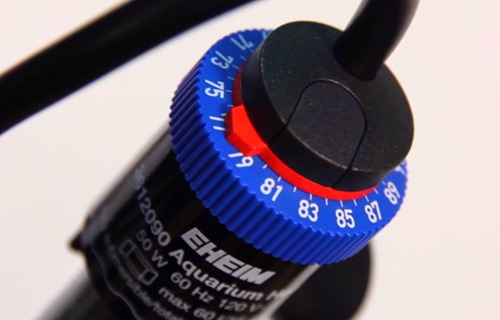
The Eheim Jager features a TruTemp dial (blue ring) with small intervals on its top for easy temperature adjustment. The temperature range is broad enough to meet the needs of most types of fish people can keep in home aquariums. Unlike other heaters, it includes a calibration ring (red ring with arrow) for you to recalibrate the heater for better accuracy after a long period of use.
It is fitted with laboratory-grade shatterproof and shock resistant glass for longevity. The Eheim Jager heater has a thermo-safety feature that turns off itself when the water levels get too low. This prevents running dry and glass breakage.
- Quality product from Eheim and manufactured in Germany
- Very reliable and durable
- Allow to recalibrate for accurate temperature
- The rare glass tube heater with running-dry protection
- No guard
Vivosun 300W Titanium Heater with Controller

 Check on Amazon #ad
Check on Amazon #ad- Type: titanium tube with external controller
- Wattage: 300W (50-400W available)
- For tanks: 50 – 60 Gal
- Temperature range: 68-94°F (20-34°C), ±2°F/1°C
- Features: water temperature reading, built-in thermometer, separate digital thermometer, running dry protection
The Vivosun 300W titanium heater is a cheap and affordable titanium from China. It has a sleek and slender design that doesn’t take up much space inside the aquarium. The matte black finish also gives it a more discrete appearance.
It has most of the features built into the cap of the heater, which reduces the equipment you have around the aquarium. The components inside the cap include a highly sensitive thermometer inside the top of the cap and a bright LED that shows the current water temperature.
With the heater, you also get an external controller with a temperature range of 68 – 94°F. The controller has a simple and easy-to-use layout, so you don’t have to worry about having difficulty setting up the heater.
- Affordable China titanium heater if you are on a budget
- Multi functional
- External digital controller for easily handling
- Separate digital thermometer for temperature verification
- No guard
HITOP Digital Titanium Heater with External Controller

 Check on Amazon #ad
Check on Amazon #ad- Type: titanium tube with controller
- Wattage: 600 watts
- For tanks: 75-180 Gal
- Temperature range: 64-93°F (18-34°C), ±1°F
- Features: dual-temp display, °F & °C switch, out of water protection
The HITOP Digital Titanium Heater is no doubt a very innovative aquarium heater and a must-have if you keep tanks between 75 and 180 gallons in capacity. This heater will make life easier for you with its digital dual-temperature display. The numbers are large enough so you can easily read the temperature even at a quick glance. It also comes with an indicator for the heater’s working status so you know immediately whether it’s functioning properly or not.
With the heater’s external controller, you can set and adjust the temperature with ease. And with a temperature range of 64.0°F to 93.0°F, this heater allows you to play between a wide range of temperatures to suit your needs.
One of the excellent things about this heater is its dual probe design. This allows the heater to detect the temperature in real-time and make adjustments with very high accuracy. Finally, with a built-in overheating protective feature, you can rest assured that this heater will automatically shut down the moment the temperature suddenly exceeds 95°F.
- Best titanium heater for large fish tanks
- Multi functional
- One-button controller for easily handling
- Show both set and now temp
- Heater guard protects your aquatic pets
- Nothing
Finnex Deluxe Titanium Tube Heater 800-watt

 Check on Amazon #ad
Check on Amazon #ad- Type: titanium tube with external controller
- Wattage: 800 watts (300/500/800W available)
- For tanks: 140 – 265 gallons
- Temperature range: 0-99°F, ±2°F, adjustable
- Features: water temperature reading
Finding a heater for a 265-gallon aquarium is not easy. Finnex has one that is not only up to the task but has all the necessary features to ensure safety for you and the fish.
The Finnex Deluxe Titanium tube heater features a corrosion-resistant and explosion-proof tube that is virtually unbreakable! It is safe to use in both freshwater or saltwater aquariums.
The heater comes with an external controller for easy temperature adjustments and control. This controller can work with any heating tube with a 3-prong connector whether it’s the same brand or not.
If you have some large fish in the aquarium, you’ll be happy to know that the heater comes with a protective guard to keep the fish safe.
- Very reliable and durable option for large aquariums
- External digital controller for easily handling
- LED-display controller shows realtime water temperatures
- No guard
How to install an aquarium heater?
Step 1 – Set the temperature

Most standard aquarium heaters often simply have a knob for you to set the desired temperature. If you have tropical fish, select one in the range from 75 to 80°F (24-27 °C) based on the tank species. 78°F is ideal for most tropical tanks.
Do NOT plug it in when out of the water. Don’t just plug the heater in to see it heat up in your hand then put it right away into the water. Placing a hot tube into the water is a great way to break the glass. It is not so difficult to do. Only plug the heater in when it is fully submerged in water.
You can adjust the temperature setting once power is applied. There is no problem with this, but ensure NOT to take the heater out of the water when it is working. The sudden change between the warmed water and cooler room temperature can weaken the glass.
Step 2 – Place it in a proper position
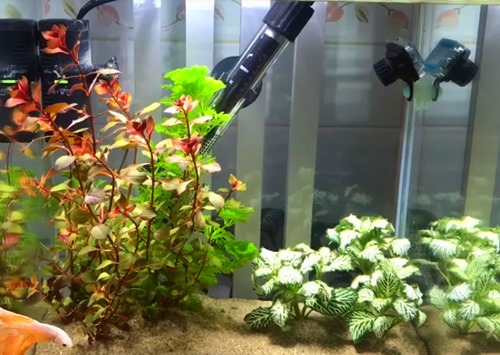
Most aquarium heaters today are submersible and placed entirely under the water for their service life. When the aquarium is full, place the heater into position.
Do not place glass aquarium heaters in a place where it is touched by anything. The heater tube must be fully exposed to the water around it. This prevents hotspots from building up and weakening the glass where a rock or ornament prevents the even distribution of heat off the glass.
NEVER bury the heater into the gravel if it is not a substrate heater. Any wrong placements that disrupt the thermal conduction of the heater will cause the uneven distribution of heat and the tube will burst.
Aquarium heaters should be placed as directly in the filter flow as possible. This allows the heat to be pulled from the heater tube and evenly distributed around the tank as a whole. Proper current will prevent thermal layering from occurring. This is where inadequate currents are generated in the tank so some spots are left stagnant.
You can place your heater vertically or horizontally, there is no science behind this. It is convenient to place the heater horizontally, near the bottom of the tank so that it is always submerged in the water, even when you do weekly partial water changes. And you don’t need to plug it out before water changes.
Ensure that you have no problem with the tank leakages and the water level gets lower than the point where the heater element may become exposed.
Step 3 – Daily temperature verification
 Zacro LCD Digital Aquarium Thermometer #ad
Zacro LCD Digital Aquarium Thermometer #ad
Make sure the temperature you are trying to get is the one you get. You should always have a reliable independent thermometer to verify the temperature in the tank. Verify the reading once a day as part of your regular aquarium maintenance.
I always put my hand on the side of the tank when I verify the temperature. Over time I have come to know the temperature “by hand”. I usually know if there is something wrong before I even look at the thermometer.
Accessories and replacement components
Heater guard
 This guard fits most fish tank heaters #ad
This guard fits most fish tank heaters #ad
Also called an aquarium heater cover or mat, this is one of the essential accessories for your aquarium heater. It’s even more critical if you have a big aquarium that requires a high-powered heater.
The aquarium guard covers the heating surface of the aquarium, ensuring that fish don’t get burnt in case they touch or get trapped behind the heater. An aquarium guard can also protect you from accidentally touching the heater while conducting maintenance or a water change. The guard is often a plastic cover attached over the heating area of the heater.
Suction cups
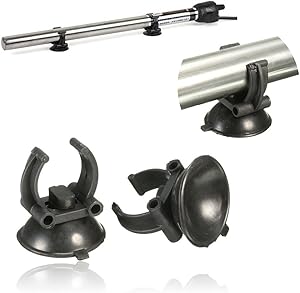 Suction cups for aquarium heaters #ad
Suction cups for aquarium heaters #ad
Suction cups are a vital part of setting up an aquarium, and they feature prominently in aquarium heaters. The role of suction cups is solely installing and keeping the heater in place.
Using the suction cups, you can install most submersible heaters horizontally or vertically. The cups are also used in various other functions like holding filters, hoses, and decorations in place.
Magnetic suction cups
 Zoo Med MagClip Magnetic Suction Cups #ad
Zoo Med MagClip Magnetic Suction Cups #ad
Suction cups are affordable and easy to use. But every time you want to reposition the heater, you have to dip your hands into the aquarium not to mention, ordinary suction cups get damaged easily.
Magnetic suction cups are designed to remedy these challenges. Just like ordinary suction cups, these are easy to use, and you can reposition the heater without getting your hands wet. Magnetic suction cups also offer more longevity and better value for money.
Heater controller
 Inkbird WiFi ITC-308 Digital Temperature Controller #ad
Inkbird WiFi ITC-308 Digital Temperature Controller #ad
This equipment helps reduce your work of daily temperature verification. With a heater controller, you don’t have to check your aquarium water temperature every day. The controller will regulate the water according to your set parameters automatically. Most importantly, it will prevent overheating, which can damage the heater and ‘boil’ the fish.
In case you’re concerned about the quality of your heater, using a heater controller can bring you peace of mind and make it easier to provide your fish with the right temperature. It likes a two-step temperature verification.
Frequently asked questions and common problems
How does aquarium heaters work?
Most aquarium heaters are operated using a temperature control thermostat to sense ambient temperatures and automatically open or close the electrical circuit that heats the inside heating core. In this way, the heater maintains the aquarium water at the desired temperature with very little fluctuation. Most heaters have an LED light indicator integrated into the unit that burns whenever the heater is actually operating.
How to safely remove a glass heater?
It doesn’t happen often, but sometimes aquarium heaters must be removed. If the heater has been running, it should be unplugged for at least a half-hour before being exposed to the cool atmosphere. Keep in mind that any sudden change of temperatures can deteriorate the glass and it may explode at any time without any warning.
The heater keeps falling off
This is one of the simplest but most common aquarium heater problems to fix. The suction cups are simply worn out and can’t hold the weight of the heater. The fix is as simple as buying new suction cups. Alternatively, you can opt for magnetic suction cups #ad, which last longer.
Will an aquarium heater melt plastic?
When positioned properly, heaters don’t pose any risk to plastic, especially your acrylic tank. But, if the heater is resting directly on the tank, it could burn it. It’s important to make sure the heater is not resting on the sides of the aquarium or plastic plants and decorations.
Can an aquarium heater burn fish and plants?
It is rare, but it happens. That is why you should install an aquarium guard. Also, ensure the placement of the heater is at a safe distance from plants and décor.
Can the aquarium heater touch the glass?
You should always take caution when setting up your heater to ensure it doesn’t touch the aquarium glass. Equally, the heater should not touch the gravel (unless it’s the under-gravel heater) or an ornament inside the tank. This ensures proper heat distribution and prevents damage to the décor or the heater itself.
How to hide the aquarium heater
The best way to hide the aquarium heater is to have it inside the sump. You can also hide the heater behind backgrounds, rockwork, or large décor.
Is an aquarium heater necessary for a flowerhorn?
Flowerhorns require a temperature of at least 80°F, which means it is necessary to have a fish tank heater to keep flowerhorns.
What is the best heater for saltwater aquariums?
Most fish tank heaters will work in both freshwater and saltwater. If quality and longevity are a concern, titanium heaters are the best because they are corrosion resistant.
Energy consumption and running cost
The energy and consumption of a heater depend on its watt rating. The more the watts, the higher the energy consumption and running costs.
For example, a 100-watt heater will consume about (100W x 24 hours x 365 days)/1000 = 876 kWh annually. With the average electricity rate of 13.6 cents per kilowatt-hour, it costs approximately $119 annually, approx. $10 monthly.
The real number is smaller, based on how many hours the heater works in a day. Depending on the actual room temperature and how well the system is closed down, the heater may run all the time or very little. This is the strong reason why your tank needs to have a canopy to prevent both evaporation and heat loss.
Overheating aquarium heater
Several factors could lead to overheating. It is possible the heater is too powerful for your tank. In this case, you need to get an alternative heater with a lower power rating.
If that’s not the case, you should also check to ensure the adjustable heat setting is within the right temperature and check the thermometer to ensure it’s working correctly. If none of these is causing the problem, it’s possible your heater is malfunctioning and needs to be replaced.
The indicator light is on but the heater is not working
The reason is usually a loose or disconnected contact. Unfortunately, there’s not much you can do about that. If the heater is still under warranty, you can send it back to the manufacturer to get a replacement.
Hissing or a clicking noise
Heaters shouldn’t make a sound. However, some designs make a clicking noise when the thermostat kicks in. When the clicking sound is continuous or happens at any other time, your heater could be failing.
The hissing sound points to a more serious problem. Hissing can be caused by failed seals that let water sip into the heating chamber. When the cold water touches the hot element, it produces a hissing sound as it evaporates.
In cases where the leaking is significant, you can hear a knocking or popping sound, which is water inside the heater boiling. In all these cases, you should have the heater replaced immediately.
How often should you replace your aquarium heater?
The expiration of your heater depends on its quality. Some can last for many years, while others have shorter longevity. A general rule of thumb is to change the heater every two years just to be on the safe side.
How to repair an aquarium heater?
Aquarium heaters are water-tight, taking apart a heater can compromise its seals allowing water to sip into the heater, causing it to short-circuit. In most cases, it’s best to replace the heater if it fails. While it’s possible to repair the heater, it’s not worth the risk it poses to you and your fish.

 Intelligent Water Sensor #ad
Intelligent Water Sensor #ad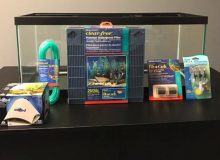


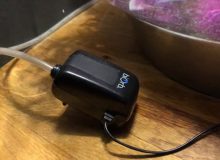
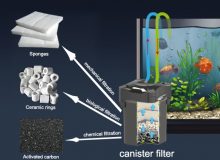
Leave a Reply